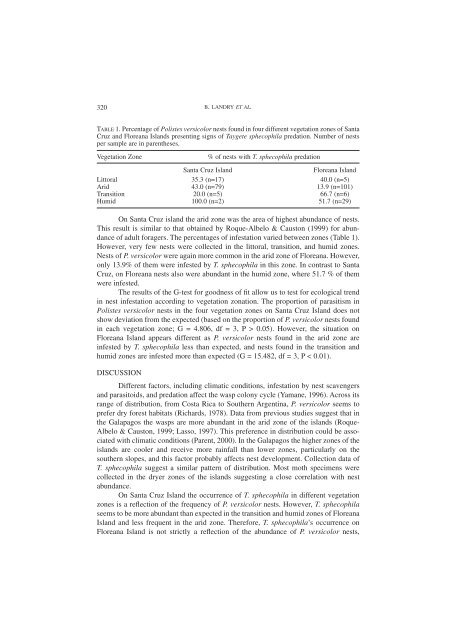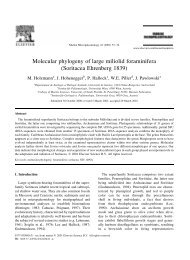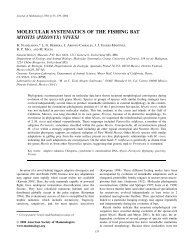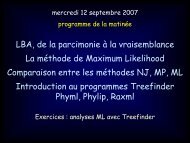320B. LANDRY ET AL.TABLE 1. Percentage of Polistes versicolor nests found in four different veg<strong>et</strong>ation zones of SantaCruz and Floreana Islands presenting signs of Tayg<strong>et</strong>e sphecophila predation. Number of nestsper sample are in parentheses.Veg<strong>et</strong>ation Zone% of nests with T. sphecophila predationSanta Cruz IslandFloreana IslandLittor<strong>al</strong> 35.3 (n=17) 40.0 (n=5)Arid 43.0 (n=79) 13.9 (n=101)Transition 20.0 (n=5) 66.7 (n=6)Humid 100.0 (n=2) 51.7 (n=29)On Santa Cruz island the arid zone was the area of highest abundance of nests.This result is similar to that obtained by Roque-Albelo & Causton (1999) for abundanceof adult foragers. The percentages of infestation varied b<strong>et</strong>ween zones (Table 1).However, very few nests were collected in the littor<strong>al</strong>, transition, and humid zones.Nests of P. versicolor were again more common in the arid zone of Floreana. However,only 13.9% of them were infested by T. sphecophila in this zone. In contrast to SantaCruz, on Floreana nests <strong>al</strong>so were abundant in the humid zone, where 51.7 % of themwere infested.The results of the G-test for goodness of fit <strong>al</strong>low us to test for ecologic<strong>al</strong> trendin nest infestation according to veg<strong>et</strong>ation zonation. The proportion of parasitism inPolistes versicolor nests in the four veg<strong>et</strong>ation zones on Santa Cruz Island does notshow deviation from the expected (based on the proportion of P. versicolor nests foundin each veg<strong>et</strong>ation zone; G = 4.806, df = 3, P > 0.05). However, the situation onFloreana Island appears different as P. versicolor nests found in the arid zone areinfested by T. sphecophila less than expected, and nests found in the transition andhumid zones are infested more than expected (G = 15.482, df = 3, P < 0.01).DISCUSSIONDifferent factors, including climatic conditions, infestation by nest scavengersand parasitoids, and predation affect the wasp colony cycle (Yamane, 1996). Across itsrange of distribution, from Costa Rica to Southern Argentina, P. versicolor seems toprefer dry forest habitats (Richards, 1978). Data from previous studies suggest that inthe G<strong>al</strong>apagos the wasps are more abundant in the arid zone of the islands (Roque-Albelo & Causton, 1999; Lasso, 1997). This preference in distribution could be associatedwith climatic conditions (Parent, 2000). In the G<strong>al</strong>apagos the higher zones of theislands are cooler and receive more rainf<strong>al</strong>l than lower zones, particularly on thesouthern slopes, and this factor probably affects nest development. Collection data ofT. sphecophila suggest a similar pattern of distribution. Most moth specimens werecollected in the dryer zones of the islands suggesting a close correlation with nestabundance.On Santa Cruz Island the occurrence of T. sphecophila in different veg<strong>et</strong>ationzones is a reflection of the frequency of P. versicolor nests. However, T. sphecophilaseems to be more abundant than expected in the transition and humid zones of FloreanaIsland and less frequent in the arid zone. Therefore, T. sphecophila’s occurrence onFloreana Island is not strictly a reflection of the abundance of P. versicolor nests,
TAYGETE SPHECOPHILA IN THE GALÁPAGOS ISLANDS321suggesting that other ecologic<strong>al</strong> or climatic factors might influence its distribution. Itis not clear why there is such a difference b<strong>et</strong>ween Floreana and Santa Cruz islands,but one possible hypothesis is that T. sphecophila has colonized these two islands atdifferent points in time, so that populations on one of the island have had more time toadapt to the island’s ecologic<strong>al</strong> and climatic context.Polistes nests, as in many other soci<strong>al</strong> wasps, are scavenged and parasitized byvarious insects including more than 11 moth species from four families (Makino,1985). Only Tayg<strong>et</strong>e sphecophila was found in the G<strong>al</strong>apagos, where the speciesapparently prefers to attack large nests, and <strong>al</strong>l infested nests collected were largeenough to presume that they were in an advanced stage of the reproductive phase. Ifpredation by T. sphecophila is restricted to this stage of the wasp colonies the probabilitiesfor this moth species to be an effective agent of biologic<strong>al</strong> control are reduced.These results support the idea of Miyano (1980) that parasitic and scavengingLepidoptera reduce notably the colony’s productivity but are not thought to be a directcause of colony failure. However, the possibility to use T. sphecophila as a biologic<strong>al</strong>control agent against P. versicolor needs to be ev<strong>al</strong>uated.We believe that the first individu<strong>al</strong>s of Tayg<strong>et</strong>e sphecophila probably arrivedwithin a nest of P. versicolor built on some human-made structure that would hav<strong>et</strong>raveled by boat from the continent. It is actu<strong>al</strong>ly quite possible that both anim<strong>al</strong>sarrived tog<strong>et</strong>her on the G<strong>al</strong>apagos. The wasp was first d<strong>et</strong>ected in 1988 on Floreana,and is thought to have arrived with a shipment of bananas (Abedrabbo, 1991), butEduardo Vilema, resident of Santa Cruz, says that he first saw a nest of Polistes versicolornear Bella Vista, on Santa Cruz, in 1984 or 1985 (pers. comm. to BL in 2004).And we think it unlikely that the wasps came on banana regimes as they are not knownto build their nests there.ACKNOWLEDGEMENTSBL would like to thank the authorities of the CDRS and G<strong>al</strong>apagos Nation<strong>al</strong>Park Service (GNPS) for providing authorizations and logistic<strong>al</strong> support for samplingmicro moths in 1989, 1992, 2002, 2004, and 2005. The first two expeditions wereorganized by Stewart B. Peck, Carl<strong>et</strong>on University, Ottawa, and benefited fromfinanci<strong>al</strong> support of the Nation<strong>al</strong> Sciences and Engineering Council of Canada.Professor Peck, as well as Bradley J. Sinclair and sever<strong>al</strong> others were excellent fieldcompanions. BL is <strong>al</strong>so grateful to Jean-François <strong>Landry</strong>, Agriculture & Agri-FoodCanada, Ottawa, for providing lab space, equipment and technic<strong>al</strong> support in 1999-2000. We are thankful to curator Kevin Tuck of the Natur<strong>al</strong> History Museum, London,for his kind help to BL in London and for providing information on referencesregarding T. sphecophila and on specimens of other species. Financi<strong>al</strong> support for BL’sinvestigations in London in 2000 were provided by the G<strong>al</strong>apagos Conservation Trust,United Kingdom, and the Charles Darwin Foundation.PS would like to thank the CDRS and GNPS for <strong>al</strong>lowing field work andproviding logistic<strong>al</strong> support in the G<strong>al</strong>apagos in 2004 and 2005. Research funds to PSwere provided by the A. Lombard Foundation, the E. & L. Schmidheiny Foundation,the Swiss Academy of Sciences, and the Department of cultur<strong>al</strong> affairs of the city ofGeneva.






